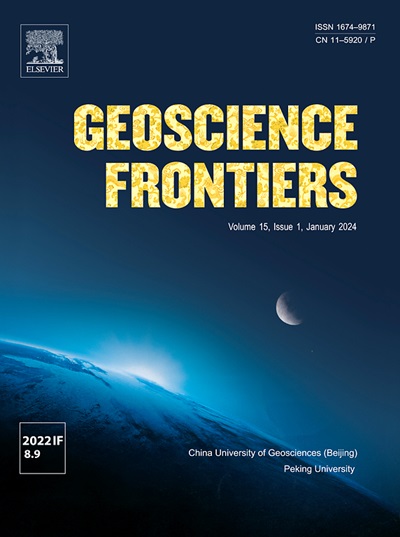从俯冲到弧-陆碰撞的物源演化:以扎格罗斯-马克兰过渡带为例
IF 8.9
1区 地球科学
Q1 GEOSCIENCES, MULTIDISCIPLINARY
引用次数: 0
摘要
弧-陆碰撞带是隆起、增生和侵蚀过程显著影响大陆地壳生长、消除或再循环的关键区域。Zagros - Makran过渡带位于Minab-Zendan断裂沿线,是伊朗南部自白垩纪以来Zagros大陆域与Makran增生棱镜之间的汇聚边界。新特提斯蛇绿岩残余物、甘孜杂岩和巴甘孜—德尔坎杂岩等构造板块在马可兰西部楔体俯冲过程中沿欧亚板块南缘增生。为了明确马兰棱柱的发育阶段和弧-陆碰撞相关的内部变形,我们对马兰棱柱西部的砂岩进行了物源研究,包括主要碎屑组分的岩石学和碎屑锆石颗粒的U-Pb测年、Hf同位素值和微量元素。研究结果揭示了始新世早期至晚始新世,~ 99马干集杂岩中Hf值在+10 ~ +16之间的洋弧相关岩石的抬升过程。始新世弧前沉积物来源于~ 49 ~ 47 Ma umumieh - dokhtar岩浆弧,Hf值在−5 ~ +12之间,以及甘吉杂岩。晚始新世至渐新世欧亚板块南缘多地体碰撞,使侏罗—白垩系巴干—德尔坎杂岩隆升。这导致大量沉积物流入Makran海沟,其碎屑信号范围为~ 175 ~ 160 Ma, Hf同位素值为−3 ~ +4,并沿乌鲁木齐-多赫塔尔岩浆弧流入,碎屑年龄范围为~ 46 ~ 37 Ma,约80 Ma。值得注意的是,晚始新世沉积物中开始出现变质岩屑颗粒。沉积物从阿拉伯边缘沿米纳布-赞丹断裂初始到达弧陆缝合带,表明了初始碰撞的开始。晚渐新世-早中新世,来自阿拉伯基底的碎屑锆石年龄在~ 610 ~ 520 Ma之间,与始新世乌鲁木齐-多赫塔尔岩浆弧和白垩纪蛇绿岩碎屑的成分在~ 93 Ma之间沉积在海沟盆地中,Hf同位素值为+12 ~ +16。中中新世以来,随着造山带的发育和隆升,在马可兰和扎格罗斯沉积域中均出现了白垩统—中新统乌鲁木齐—多赫塔尔岩浆弧、侏罗系—白垩统巴干—德尔坎杂岩和白垩统蛇绿岩的碎屑锆石颗粒。本文章由计算机程序翻译,如有差异,请以英文原文为准。

Provenance evolution from subduction to arc-continent collision: An example from Zagros–Makran Transition Zone
Arc-continent collision zones are critical areas where uplift, accretion, and erosion processes significantly influence the growth, elimination, or recycling of the continental crust. The Zagros–Makran Transition Zone, located along the Minab-Zendan Fault, represents a convergence boundary between the Zagros continental domain and the Makran accretionary prism in southern Iran from the Cretaceous onwards. Several tectonic slices, including Neotethys ophiolitic remnants and the Ganj and Bajgan-Durkan complexes, have accreted along the southern margin of the Eurasian Plate during subduction in the western Makran wedge. To clarify the growth steps of the Makran Prism and the internal deformation associated with arc-continent collision, we used a provenance study of sandstones from the western Makran accretionary prism involving petrography of the main detrital components and U–Pb dating, Hf isotopic values, and trace elements of detrital zircon grains. Our findings reveal a progressive scenario in which oceanic arc-related rocks of the ∼ 99 Ma Ganj Complex with Hf values ranging from +10 to +16 were uplifted during the Early to Late Eocene. The Eocene fore-arc sediments were sourced from the ∼ 49–47 Ma Urumieh-Dokhtar Magmatic Arc with Hf values between −5 and +12, as well as from the Ganj Complex. The Jurassic–Cretaceous Bajgan-Durkan Complex was uplifted due to the Late Eocene to Oligocene collision of various terranes along the southern margin of the Eurasian Plate. This led to a major sediment influx into the Makran trench with a detrital signal in the range ∼ 175–160 Ma with Hf isotopic values from −3 to +4 and alongside the Urumieh-Dokhtar Magmatic Arc with detrital ages ranging ∼ 46–37 Ma and ca. 80 Ma. Notably, metamorphic lithic grains began to appear in the sediments in the Late Eocene. The initial arrival of sediments from the Arabian margin to the arc-continent suture zone along the Minab-Zendan Fault indicates the onset of initial collision. During the Late Oligocene–Early Miocene, detrital zircon ages in the range of ∼ 610–520 Ma, sourced from the Arabian basement, were deposited in the trench basin together with components from the Eocene Urumieh-Dokhtar Magmatic Arc and Cretaceous ophiolitic clasts of ∼ 93 Ma with Hf isotopic values of +12 to +16. Following the development and uplift of the orogen from the Middle Miocene onward, detrital zircon grains from the Cretaceous–Miocene Urumieh-Dokhtar Magmatic Arc, Jurassic–Cretaceous Bajgan-Durkan Complex, and Cretaceous ophiolites are present in both the Makran and Zagros sedimentary domains.
求助全文
通过发布文献求助,成功后即可免费获取论文全文。
去求助
来源期刊

Geoscience frontiers
Earth and Planetary Sciences-General Earth and Planetary Sciences
CiteScore
17.80
自引率
3.40%
发文量
147
审稿时长
35 days
期刊介绍:
Geoscience Frontiers (GSF) is the Journal of China University of Geosciences (Beijing) and Peking University. It publishes peer-reviewed research articles and reviews in interdisciplinary fields of Earth and Planetary Sciences. GSF covers various research areas including petrology and geochemistry, lithospheric architecture and mantle dynamics, global tectonics, economic geology and fuel exploration, geophysics, stratigraphy and paleontology, environmental and engineering geology, astrogeology, and the nexus of resources-energy-emissions-climate under Sustainable Development Goals. The journal aims to bridge innovative, provocative, and challenging concepts and models in these fields, providing insights on correlations and evolution.
 求助内容:
求助内容: 应助结果提醒方式:
应助结果提醒方式:


